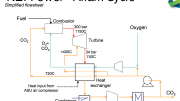In California, a new UC Berkeley study shows that if biomass electricity production is combined with carbon capture and sequestration in the western United States, by 2050 power generators could reduce emissions up to 145 percent from 1990 levels, even while retaining gas- or coal-burning plants. Such reductions can occur with as little as 7 percent of the power coming from “Bioenergy combined with Carbon Capture & Sequestration”, also known as BECCS.
 BECCS, may be one of the few cost-effective carbon-negative opportunities available to mitigate the worst effects of anthropogenic climate change, said energy expert Daniel Kammen, who directed the research. This strategy will be particularly important should climate change be worse than anticipated, or emissions reductions in other portions of the economy prove particularly difficult to achieve.
BECCS, may be one of the few cost-effective carbon-negative opportunities available to mitigate the worst effects of anthropogenic climate change, said energy expert Daniel Kammen, who directed the research. This strategy will be particularly important should climate change be worse than anticipated, or emissions reductions in other portions of the economy prove particularly difficult to achieve.
The carbon reduction might even offset the emissions from fossil fuel used in transportation, said study leader Daniel Sanchez, a graduate student in UC Berkeley’s Energy and Resources Group.
Sanchez, Kammen and their colleagues published their analysis of BECCS in western North America Feb. 9 in the online journal Nature Climate Change. Coauthors of the study are James Nelson of the Union of Concerned Scientists, Ana Mileva of Energy and Environmental Economics (E3) and Josiah Johnston of RAEL and the Energy and Resources Group.
How it works
Generating electricity from biomass, such as urban waste and sustainably-sourced forest and crop residues, is carbon-neutral: it produces as much carbon as the plants suck out of the atmosphere.
In this case, the emissions generated from the system are aggregated at a single point, the power plant — as opposed to being released at thousands of points as in the case of biofuels used in transportation. This allows the emissions to be captured — and in the case of Carbon Capture and Sequestration, stored. In this way, carbon is essentially brought from the forest, crop or residue source and used to generate energy, but the resulting emission is captured and stored. Then, the next generation of crop or forest would pull its CO2 from atmospheric carbon, accumulating stored carbon with each cycle.
Sanchez noted that burning biomass as part of BECCS may have a greater impact on greenhouse gas emissions than using these same feedstocks for biofuels, solely because of the possibility of carbon capture.
In most scenarios explored, the carbon offsets produced by BECCS are more valuable to the power system than the electricity it provides.
Not appearing at your power plant tomorrow
Though the financial costs, not to mention technological hurdles, of capturing carbon from biomass power plants and compressing it underground are huge, the Intergovernmental Panel on Climate Change (IPCC), the major international body studying the issue, assumes that it will become viable in 50 years, and includes it in its long-term predictions.
What about carbon capture and use?
The cycle of biomass aggregation, energy production and carbon capture could, concievably, be used for other outcomes such as a biomass-to-algae cycle in the years prior to the arrival of an affordable carbon capture and sequestration technology.
For example, biomass emissions could, after capture from the flue stack, be fed to microbes or to plants (via greenhouses) to produce fuels, polymers, bulk or specialty chemicals, power, sugars, protein, starches, essential oils and other products. Emissions would then be sequestered for varying periods of time — such a strategy would add value to the process while retaining a carbon-neutral to carbon-negative outcome, ensuring that such a technology would be more financially feasible.
Reaction from the principals
“There are a lot of commercial uncertainties about carbon capture and sequestration technologies,” Sanchez admitted. “Nevertheless, we’re taking this technology and showing that in the Western United States 35 years from now, BECCS doesn’t merely let you reduce emissions by 80 percent – the current 2050 goal in California – but gets the power system to negative carbon emissions: you store more carbon than you create.”
“We’re evaluating a technology with some uncertainty behind it, but we are saying that if the technology exists, it really sketches out a different kind of climate mitigation pathway than what people are assuming,” Sanchez said.
“Biomass, if managed sustainably can provide the ‘sink’ for carbon that, if utilized in concert with low-carbon generation technologies, can enable us to reduce carbon in the atmosphere,” said Kammen, a Professor of Energy in UC Berkeley’s Energy and Resources Group and director of the Renewable and Appropriate Energy Laboratory (RAEL) in which the work was conducted.
“BECCS technologies figure prominently in the IPCC’s recent Fifth Assessment Report (AR5), which focuses in part on mitigating climate change, but previous models examining BECCS deployment have not investigated its role in power systems in detail or in aggressive time frames,” said Kammen, who serves as a coordinating lead author on the IPCC.
New models
To remedy this, the UC Berkeley scientists used a detailed computer model they developed of the West’s electric power grid to predict deployment of BECCS in low-carbon and carbon-negative power systems. This model of western North America, called SWITCH-WECC, was developed in the RAEL lab. Researchers can use SWITCH to study generation, transmission and storage options for the United States west of the Kansas/Colorado border as well as in northwest Mexico and the Canadian provinces of Alberta and British Columbia.
The study relies on a detailed spatial and temporal inventory of potential bioenergy feedstocks, such as forest residues, municipal solid waste and switchgrass, as well as complimentary renewable energy, such as wind and solar power.
Jim Lane
Originally published by Biofueldigest
10 February 2015






Be the first to comment on "Biomass power generation the key to carbon-negative energy, study concludes"